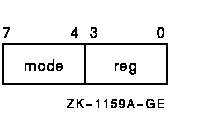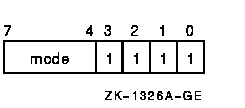![[Compaq]](../../images/compaq.gif)
![[Go to the documentation home page]](../../images/buttons/bn_site_home.gif)
![[How to order documentation]](../../images/buttons/bn_order_docs.gif)
![[Help on this site]](../../images/buttons/bn_site_help.gif)
![[How to contact us]](../../images/buttons/bn_comments.gif)
![[OpenVMS documentation]](../../images/ovmsdoc_sec_head.gif)
| Document revision date: 19 July 1999 | |
![[Compaq]](../../images/compaq.gif) |
![[Go to the documentation home page]](../../images/buttons/bn_site_home.gif)
![[How to order documentation]](../../images/buttons/bn_order_docs.gif)
![[Help on this site]](../../images/buttons/bn_site_help.gif)
![[How to contact us]](../../images/buttons/bn_comments.gif)
|
![[OpenVMS documentation]](../../images/ovmsdoc_sec_head.gif)
|
|
| Previous | Contents | Index |
The operand specifier format is as follows:

Bits 15:8 contain a second operand specifier (termed the base operand specifier) for any of the addressing modes except register, literal, or index. The specification of register, literal, or index addressing mode results in an illegal addressing mode fault (see Appendix E). If the base operand specifier requires it, a specifier extension immediately follows. The base operand specifier is subject to the same restrictions as would apply if it were used alone. If the use of some particular specifier is illegal (that is, causes a fault or UNPREDICTABLE behavior) under some circumstances, then that specifier is similarly illegal as a base operand specifier in index mode under the same circumstances.
The operand to be specified by index mode addressing is termed the primary operand. You normally use the base operand specifier to determine an operand address. This address is termed the base operand address (BOA). The address of the primary operand specified is determined by multiplying the contents of the index register x by the size of the primary operand in bytes (1 for byte; 2 for word; 4 for longword and F_floating; 8 for quadword, D_floating, and G_floating; and 16 for octaword and H_floating), adding BOA, and taking the result.
OA = BOA + {size * (Rx)}
operand = (OA)
If the base operand specifier is for autoincrement or autodecrement mode, the increment or decrement size is the size in bytes of the primary operand.
Certain restrictions are placed on the index register x. You cannot use the PC as an index register. If you use it, a reserved addressing mode fault occurs (see Appendix E). If the base operand specifier is for an addressing mode that results in register modification (that is, autoincrement mode, autodecrement mode, or autoincrement deferred mode), the same register cannot be the index register. If it is, the primary operand address is UNPREDICTABLE.
The names of the addressing modes resulting from index mode addressing are formed by adding the suffix "indexed" to the addressing mode of the base operand specifier. The following list gives the names and assembler notation (the index register is designated Rx to distinguish it from the register Rn in the base operand specifier):
This section provides summaries of general register and program counter (PC) addressing.
Table 8-5 is a summary of general register addressing and
Table 8-6 is a summary of PC addressing.
8.8.1 General Register Addressing
The general register addressing format is as follows:

| Hex | Dec | Name | Assembler | r mw a v | PC | SP | AP FP |
Can Be Indexed? |
|---|---|---|---|---|---|---|---|---|
| 0--3 | 0--3 | Literal | S^#literal | y f f f f | --- | --- | --- | f |
| 4 | 4 | Indexed | i[Rx] | y y y y y | f | y | y | f |
| 5 | 5 | Register | Rn | y y y f y | u | uq | uo | f |
| 6 | 6 | Register deferred | (Rn) | y y y y y | u | y | y | y |
| 7 | 7 | Autodecrement | -(Rn) | y y y y y | u | y | y | ux |
| 8 | 8 | Autoincrement | (Rn)+ | y y y y y | p | y | y | ux |
| 9 | 9 | Autoincrement | @(Rn)+ | y y y y y | p | y | y | ux |
| deferred | ||||||||
| A | 10 | Byte displacement | B^D(Rn) | y y y y y | p | y | y | y |
| B | 11 | Byte displacement | @B^D(Rn) | y y y y y | p | y | y | y |
| deferred | ||||||||
| C | 12 | Word displacement | W^D(Rn) | y y y y y | p | y | y | y |
| D | 13 | Word displacement | @W^D(Rn) | y y y y y | p | y | y | y |
| deferred | ||||||||
| E | 14 | Longword displacement | L^D(Rn) | y y y y y | p | y | y | y |
| F | 15 | Longword displacement | @L^D(Rn) | y y y y y | p | y | y | y |
| deferred |
The program counter addressing format is as follows:

| Hex | Dec | Name | Assembler | r mw a v | Can Be Indexed? |
|---|---|---|---|---|---|
| 8 | 8 | Immediate | I^#constant | y u u y y | u |
| 9 | 9 | Absolute | @#address | y y y y y | y |
| A | 10 | Byte relative | B^address | y y y y y | y |
| B | 11 | Byte relative | @B^address | y y y y y | y |
| deferred | |||||
| C | 12 | Word relative | W^address | y y y y y | y |
| D | 13 | Word relative | @W^address | y y y y y | y |
| deferred | |||||
| E | 14 | Longword | L^address | y y y y y | y |
| relative | |||||
| F | 15 | Longword | @L^address | y y y y y | y |
| relative deferred |
There are two operand specifier formats.

The operand specifier is a signed byte displacement.

The operand specifier is a signed word displacement.
In branch displacement addressing, the byte or word displacement is sign extended to 32 bits and added to the updated address in the PC. The updated address in the PC is the location of the first byte beyond the operand specifier. The result is the branch address A.
A = PC + SEXT(displ) |
The assembler notation for byte and word branch displacement addressing is A, where A is the branch address. Note that you must use the branch address, and not the displacement.
The following sections describe the native-mode instruction set. The
instructions are divided into groups according to their function and
are listed alphabetically within each group.
9.1 Introduction to the VAX Instruction Set
This section describes the instructions generally used by all software across all implementations of the VAX architecture.
You can find a more complete description of the instruction set in the VAX Architecture Reference Manual. The VAX Architecture Reference Manual also contains information on instructions that are generally used by privileged software and are specific to specialized portions of the VAX architecture, such as memory management, interrupts and exceptions, process dispatching, and processor registers.
A list of instructions and opcode assignments appears in Appendix D.
9.2 Instruction Descriptions
The instruction set is divided into the following 12 major sections:
Within each major section, instructions that are closely related are combined into groups and described together. The instruction group description is composed of the following:
Operand specifiers are described as follows:
name . access-type data-type |
name
A mnemonic name for the operand in the context of the instruction. The name is often abbreviated.access-type
A letter denoting the operand specifier access type:
a Calculate the effective address of the specified operand. Address is returned in a longword that is the actual instruction operand. Context of address calculation is given by data-type; that is, size to be used in autoincrement, autodecrement, and indexing. b No operand reference. Operand specifier is a branch displacement. Size of branch displacement is given by data-type. m Operand is read, potentially modified, and written. Note that this is not an indivisible memory operation. Also note that if the operand is not actually modified, it may not be written back. However, modify type operands are always checked for both read and write accessibility. r Operand is read only. v Calculate the effective address of the specified operand. If the effective address is in memory, the address is returned in a longword that is the actual instruction operand. Context of address calculation is given by data-type. If the effective address is Rn, the operand is in Rn or R[n+1]'Rn. w Operand is written only. data-type
A letter denoting the data type of the operand:
b Byte d D_floating f F_floating g G_floating h H_floating l Longword o Octaword q Quadword w Word x First data type specified by instruction y Second data type specified by instruction
Operation Description Notation
The operation of an instruction is given as a sequence of control and assignment statements in an ALGOL-like syntax. No attempt is made to formally define the syntax; it is assumed to be familiar to the reader. The notation used is an extension of the notation introduced in Section 8.7.
| + | Addition |
| -- | Subtraction, unary minus |
| * | Multiplication |
| / | Division (quotient only) |
| ** | Exponentiation |
| ' | Concatenation |
| <- | Is replaced by |
| = | Is defined as |
| Rn or R[n] | Contents of register Rn |
| PC, SP, FP, or AP | The contents of register R15, R14, R13, or R12, respectively |
| PSW | The contents of the processor status word |
| PSL | The contents of the processor status longword |
| (x) | Contents of memory location whose address is x |
| (x)+ | Contents of memory location whose address is x; x incremented by the size of operand referenced at x |
| --(x) | x decremented by size of operand to be referenced at x; contents of memory location whose address is x |
| <x:y> | A modifier that delimits an extent from bit position x to bit position y inclusive |
| <x1,x2,...,xn> | A modifier that enumerates bits x1,x2,...,xn |
| { } | Arithmetic parentheses used to indicate precedence |
| AND | Logical AND |
| OR | Logical OR |
| XOR | Logical XOR |
| NOT | Logical (one's) complement |
| LSS | Less than signed |
| LSSU | Less than unsigned |
| LEQ | Less than or equal signed |
| LEQU | Less than or equal unsigned |
| EQL | Equal signed |
| EQLU | Equal unsigned |
| NEQ | Not equal signed |
| NEQU | Not equal unsigned |
| GEQ | Greater than or equal signed |
| GEQU | Greater than or equal unsigned |
| GTR | Greater than signed |
| GTRU | Greater than unsigned |
| SEXT(x) | x is sign extended to size of operand needed |
| ZEXT(x) | x is zero extended to size of operand needed |
| REM(x,y) | Remainder of x divided by y, such that x/y and REM(x,y) have the same sign |
| MINU(x,y) | Minimum unsigned of x and y |
| MAXU(x,y) | Maximum unsigned of x and y |
Use the following conventions:
| Previous | Next | Contents | Index |
![[Go to the documentation home page]](../../images/buttons/bn_site_home.gif)
![[How to order documentation]](../../images/buttons/bn_order_docs.gif)
![[Help on this site]](../../images/buttons/bn_site_help.gif)
![[How to contact us]](../../images/buttons/bn_comments.gif)
|
| privacy and legal statement | ||
| 4515PRO_015.HTML | ||